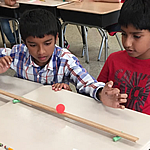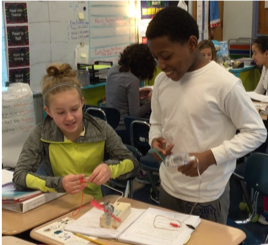Curriculum Units
Three short (4-5 session) curriculum units and an engineering design challenge include firsthand, guided explorations of energy in everyday phenomena. Beginning with easily observable phenomena, such as ball collisions, students look for signs of energy, create and use a variety of representations including "energy cubes," and discuss questions and findings. They develop the practice of asking, "Where does the energy come from?" and "Where does the energy go?" and learn to track the flow of energy in increasingly complex scenarios.

This 5-session sequence is focused on motion energy and provides foundational energy ideas. A short video collage of energy in everyday life elicits students' initial ideas. Students explore rolling and colliding balls on a track. They investigate springboard/pompom and propeller/elastic band systems and become familiar with Energy Tracking Lens questions and representations. These tools that help them describe everyday phenomena in terms of energy.

In the thermal energy unit, students investigate flow of thermal energy, using the same Energy Tracking Lens framework and representations they met in the introductory motion unit. They collect temperature data and reason about increases and decreases of thermal energy and energy transfer between objects and to the environment.

In the electrical energy unit, students use a hand-crank generator, solar panel, and capacitor to explore energy transfer to a propeller. They apply their ideas about energy to windmills and energy storage. By the end of the unit, students have developed and are able to use a model of energy to reason about energy flow in multiple contexts.

In this 2-period optional challenge, students work on solving a practical problem: How can you use simple materials in the supplied kit to modify a car so that it comes to a stop exactly where you want? The strategy they are asked to use is to transform some of the car’s motion energy into thermal energy— the same strategy they use to stop a bicycle or scooter. The process of analyzing the energy flow through a new system—one of their own design—helps students consolidate their understanding of energy transfer, transformation, and dissipation.